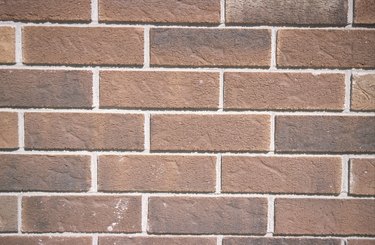
All home building materials have some insulating properties, but some keep homes comfortable more efficiently than others. Builders express insulation effectiveness as an R-value, or the measure of heat flow resistance. Higher values indicate a more insulative material; lower values indicate a material that allows more heat to pass through. Brick, wood and fiberglass are all common building materials but have very different R-values.
Brick
Video of the Day
Brick is a strong, durable material that has been used in homes for hundreds of years. However, brick alone has very little insulating power. Common red clay brick has an R-value of 0.2 per inch, while denser, stronger face brick offers only 0.11 per inch. The average 4-inch common brick provides an R-value of 0.80. Four-inch face brick rates 0.44. Traditional structural brick walls were built using two layers of brick, tied together at intervals with bricks turned sideways, and included a small airspace between the layers. This can slightly increase the insulation value of a brick wall. However, brick alone usually insulates poorly.
Video of the Day
Fiberglass
Fluffy fiberglass batting or chopped blown fiberglass are two of the most popular types of home insulation in the United States. This material is made up of many tiny glass threads with air spaces between them. The trapped air helps keep heat from escaping through the material. According to Colorado Energy, fiberglass batts provide an R-value of between 3.14 and 4.30 per inch. Blown fiberglass in walls and attics provide between 2.20 and 4.40, depending on how tightly the fiberglass is packed. Fiberglass insulation loses some of its insulating power if it gets wet or is compacted tightly.
Wood
Most homes built since the mid-20th century are wood-framed. This material is lightweight, inexpensive and provides better insulation than brick but is still a relatively poor insulator. In general, denser woods, such as oak, have a lower R-value than less dense woods, such as pine. Framing wood usually averages an R-value of around 1.25 per inch, or around 4.38 per 2x4. Most hardwoods have R-values around 0.71 per inch, making them a poorer choice for keeping heat in the home, despite their durability. Like brick, wood homes are usually augmented with extra insulation.
Thermal Mass
Many materials with poor insulation values still help homes stay warm in cold weather and cool in warm weather. This is due to their density, which translates to a high thermal mass. Very dense materials, such as brick, stone and some hardwoods, heat up and cool down very slowly. They can retain heat over a long period of time rather than transferring it directly into the home or the outside air, the way metal and glass tend to do. Combining high thermal mass materials such as brick with high insulation value materials such as fiberglass can help reduce the amount of energy needed to heat or cool a home.